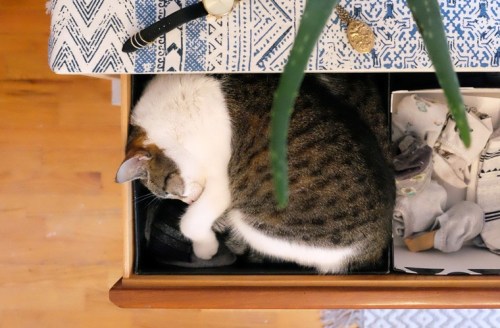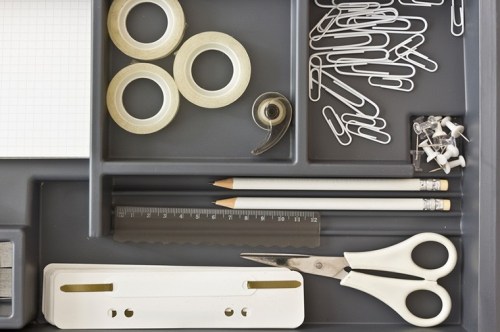Our editors independently select these products. Making a purchase through our links may earn Well+Good a commission
The right way to finally tackle your junk drawer (and *keep* it tidy)
An organizational expert explains the best way to clear out that catch-all place in your home.

Maybe it’s in your kitchen or your bedroom dresser or even your foyer table—but everybody’s got one: a catch-all place for all the stuff you accumulate (flyers, bills, sticky socks—just me?).
“Junk drawers are so prevalent and so appealing because they’re the chaos you don’t have to deal with,” says Rachel Hoffman, author of the new book Unf*ck Your Habitat: You’re Better Than Your Mess. “Once you close that drawer, it’s like you’re sending its contents to another dimension. We pretend you never have to think about it.”
“Your possessions shouldn’t make you feel bad.”
Except, when you do. You go fishing for your spare car key or AAA batteries or extra hair ties and you can’t find them amid the chaos, or a houseguest goes looking for the silverware drawer and the junk drawer’s contents explode in her face. Maybe you just feel a sliver of ick every time your eyes alight on that semi-hidden spot of stray everything. “Your possessions shouldn’t make you feel bad,” points out Hoffman. (Marie Kondo would be proud.)
But if you’ve got 20 minutes, you can wrestle that junk drawer into submission and get back to being your Zen, guilt-free self. Here’s how to do it.

Resist the urge to dump it out
Starting with a clear surface is standard organizer advice, but Hoffman says it’s best to hold back. “Taking everything out can feel really overwhelming,” she says. Instead, she suggests approaching the space in quadrants. Focus on just one-fourth of the space at a time, so if you lose steam halfway through you’re not left with a mess on your countertops.
Toss the trash
Chances are, the important things you keep in your junk drawer (your lease, an in-case-of-emergency flashlight) are buried under expired coupons, dead markers, and broken pens. Get to a trash can, stat. “You want to be more ruthless than you feel like you should,” says Hoffman. “You hold onto a lot of things for what-if scenarios, but what-if often doesn’t happen.”
If you’re on the fence about an item, ask yourself: When was the last time I used this thing? What’s the worst-case scenario if I got rid of this? Can I afford to replace it? “I’m not a big proponent of just throwing stuff away, because a lot of people aren’t comfortable discarding things only to replace them later,” she says. But if you’re talking bobby pins and broken incense, sometimes thinking about the price tag and the months since you last even touched your diffuser can give you the needed nudge to purge.
Take a house field trip
“There always seem to be hair ties and chopsticks in a junk drawer—but when’s the last time you looked there for either,” says Hoffman. Grab the hair ties and travel shampoo and head to the bathroom, put the chopsticks and plastic cutlery in the silverware drawer, move the spare screws and nails to the toolbox. “Between moving things to their rightful spots and throwing out the obvious trash, you’re guaranteed a slightly less terrifying number of things,” she says.
Pick a system
You need a way to divvy the space into discrete sections, or you’ll be back to square one (see: sloppy, disastrous heap) in a matter of weeks. What you pick is less important than picking something, so now’s the time to put your old jewelry boxes or candle jars to good use. If you’ve got nothing on hand, check out the silverware or office desk dividers at your local home goods store. (As if you needed an excuse to go to the Container Store.)
Work back to front
Most people have an easier time picking out what’s not that important, says Hoffman, so fill the back of the drawer first: maybe the bike lock you might one day use if you switch up your SoulCycle habit for an actual pair of wheels, or the spare keys for your biannual house guests. Then work your way forward in the drawer, so your most-used items are front and center. “And a helpful note on the take-out menus that seem to take up so much room in junk drawers: Use a binder clip or paper clip,” says Hoffman. “You can have 100 menus and still look less disorganized, as long as they’re neatly stacked.”
Pick a junkiversary
“Once a month, you need to spend 20 minutes resetting the junk drawer to keep it from snowballing into chaos again,” says Hoffman. Maybe it’s the first of the month or the first Sunday or whatever. But pick a date and stick to it. “I think it’s easy to look at the junk drawer as something you need to get rid of—but it really does serve a specific purpose,” she says. “If you look at it as something you need to work with and maintain, you won’t feel like you’re constantly doing battle.”
First your junk drawer, now the rest of your home: Here’s how to give your pad an energy makeover. And this is how to transform your bathroom into an oasis.
Sign Up for Our Daily Newsletter
Get all the latest in wellness, trends, food, fitness, beauty, and more delivered right to your inbox.
Got it, you've been added to our email list.








